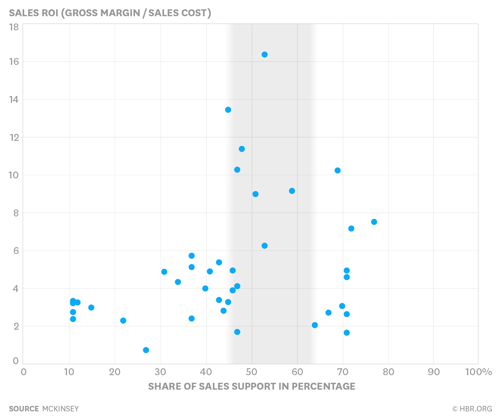McKinsey, HBR: How much support do your sales people need?
May 31, 2016

 There is some fascinating research just published in the Harvard Business Review by a group of McKinsey consultants. They sought an evidence-based approach to optimising the balance between front line sales people and sales support roles - and their conclusions may surprise you.
There is some fascinating research just published in the Harvard Business Review by a group of McKinsey consultants. They sought an evidence-based approach to optimising the balance between front line sales people and sales support roles - and their conclusions may surprise you.
It’s an important question because having the appropriate level and type of back office support is critical to maximising the productivity and effectiveness of your quota-carrying sales people. But - unfortunately - it’s a balancing act that many organisations seem to struggle to get right…
The researchers from McKinsey concluded that the highest performing organisations (as measured by sales ROI - i.e., the gross margin over total sales cost) were dedicating between 50-60% of total sales headcount to sales support functions. You can see just how much of an impact this made in the chart below:

The functional balance within the sales support function turns out to be critically important. Top-performing sales organisations have about the same percentage of customer-facing sales support personnel as do their lower-performing competitors (about 30%). But there is a fundamental difference in operational and administrative support levels, where top performers employed over twice as many specialists (27% vs. 12%).
HOW MANY MANAGERS?
The study found that the ratio between non-managers to managers also has a significant impact on performance. The highest performing organisations tended to have a non-manager to manager ratio of around 8:1. This appears to be the optimal level: their lower performing peers typically had ratios above 10:1 or below 5:1.
There’s an obvious balance that must be struck between span of control and overhead cost - and the top performers have mastered it. Employ too many managers, and you incur cost without incremental benefit. Employ too few managers, and your sales people will not get enough coaching and support to allow them to realise their potential.
GOING DIGITAL
The study found that the top performing organisations have also mastered another critical function - they were successfully using digital technology to optimise the planning and operational functions in key areas such as sales analytics, opportunity allocation, forecasting and proposal development.
These results are impressive. Perhaps just as impressive are the sales performance transformations that have been achieved by organisations that have taken an informed, evidence-based approach to structuring and resourcing the sales function and balancing roles and responsibilities.
REBALANCING YOUR RESOURCES
This often involves role specialisation and a blend of consolidating certain roles and distributing others to achieve the optimal resource balance. In addition to nearly doubling the amount of productive sales time spent on customer-facing activities, these benchmark organisations also demonstrated increased win rates and shortened sales cycles.
And they didn’t just achieve a one-time upturn in performance: moving to an intentional, evidence-based structure also helped these organisations to establish the foundation for a programme of continuous incremental performance improvement.
The authors conclude, “Sales support is critical. Only by putting into place and optimising the right levels of support can companies hope to get the greatest growth from their sales organisation.”
STRUCTURE AND PROCESS
But what’s the best way of achieving this? It seems to me that having a clearly defined sales process with clearly defined roles, responsibilities and contributions for every member of the sales organisations is one of the critical foundations.
If we’re not clear what value we expect team member to generate - and if we haven’t identified how low-value tasks could be offloaded from high-value roles to a sales support function - it’s going to be impossible to optimise our sales structures.
FOCUS ON VALUE CREATION
A good place to start would be to identify how the quota carrying roles we expect to generate the highest revenue contribution are actually spending their time. How much of it is spent on low-value-added activities that divert them from their primary purpose and could be delegated to others?
How much of their time is currently being wasted “reinventing the wheel” or relearning lessons that someone else in the organisation is already aware of? How much attention is being paid to capturing collective best practice or to reducing the unnecessary burden of administration?
If we were to take a dispassionate look at the situation, the answers would probably make many sales leaders somewhat uncomfortable. We can't "hire our way" out of the problem: the solution lies more in putting the right resources to work with the right responsibilities within a well-defined structure and process than hoping more or better recruitment will solve our sales productivity challenge.
You can read the full HBR article here. If you recognise any of these challenges - and if you see the potential to do better within your own organisation - I’d love to talk. You can drop me a line here.




Comments